Getting Started: A Beginner’s Guide to Improvising a Bass Line
Whether you are a beginning bassist, or an accomplished musician who is simply accustomed to reading written music, it can be daunting when first asked to improvise a bass line. Some people stumble, others freeze. Some think they need to be well versed in college level theory. However, there is no reason to fear even if you know only a small bit of music theory, or nearly none.
For our current expedition, we will use a simple blues progression in C as our song form. (The Roman Numerals are used to identify chords by scale degrees, so you can easily transpose this into any key).
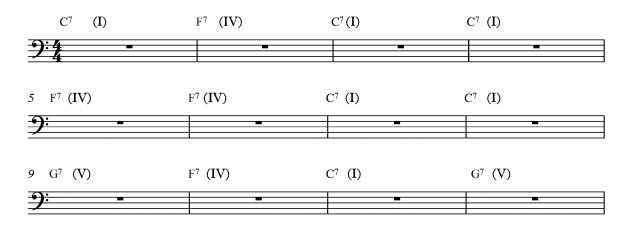
Despite the complexity and sheer awesomeness of some bass lines, there are basically just three concepts people apply when improvising a bass line. These are: Riffs, Arpeggios and Walking.
Riffs:
A riff is just musical idea that repeats. It can be simple or complicated, short or long. For our purposes we will make it a simple one bar idea. Here’s one starting on C.
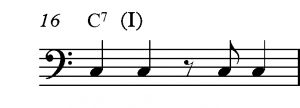
To make a bass line out of this, we simply repeat the same pattern each bar, changing the first note of the riff (in this case all the notes are the same) to match the chord played in that bar.
When we do, it looks like this:
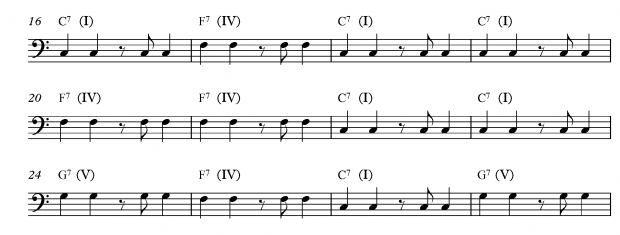
Obviously you can come up with hipper riffs, but the concept will see you through.
Arpeggios:
To create a bass line with arpeggios, we use the same principle as when playing a riff. Play notes from within the chord (the arpeggio), repeat as needed, and change the arpeggio when the chord changes. Of course we can be as complex or simple as we like. For now, however, we will keep it simple.
Here’s an arpeggiated pattern that you’ve likely heard before. We can use any of the notes from the arpeggio, but here we are using the root the seventh and the fifth only.
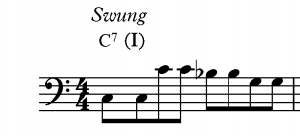
Apply it to the changes and, voila! Bass line.
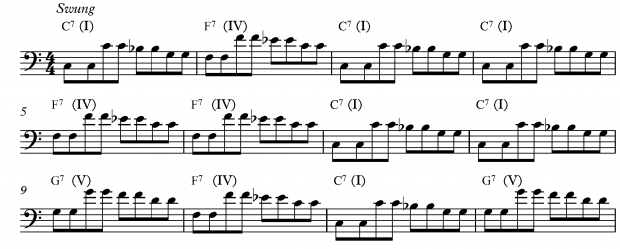
Finally, we have Walking.
Although knowledge of chords/scales, etc. can be very helpful, simply getting started doesn’t require a textbook. Play the root of the chord when the chord changes, and fill in the gaps between the roots of the chord with, primarily, half steps and whole steps. The goal is to land on the root note when a chord changes. We can go up, or down, or both. We can play a third instead of a step if we wish (just don’t it twice in a row, or we are playing arpeggios) and it’s also OK to repeat a note so you end up where you want, when you want.
Below is a simple walking bass line, applying the above concept, which keeps us in the lower positions:
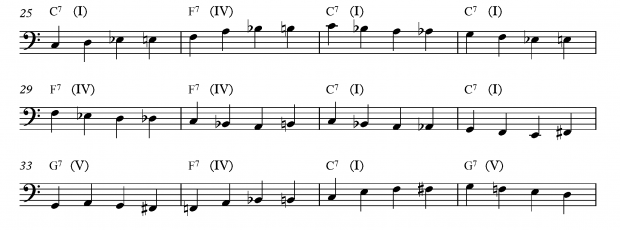
Your first walking line may not be the walking line to end all walking lines, but by following the concept above you can play something functional and get started.
Whether playing Riffs, Arpeggios or Walking, as you play multiple choruses remember what you like and what you don’t. Adjust your lines to suit your taste.
No need to fear, the more you play the more you will like what you play.
Many bass lines use a combination Riffs, Arpeggios and Walking, of course. So, feel free to mix and match to create the lines you want. The more comfortable you get, the more you can apply theory, switch between concepts, expand on the concepts and search for your own artistic note choices.
Improvising your first bass line is nothing to fear, even for the beginner and those not used to applying theory as they play. The basics are fairly straightforward and knowing them can get you started and over any crippling self-doubt. Once you get started, it’s fun to explore and to see what you can come up with. Anyone can improvise.
**Special thanks to Inez Wyrick who first showed me these ideas to get students as young as 8 improvising their own bass lines!
Dr. Donovan Stokes is on the faculty of Shenandoah University-Conservatory. Visit him online at www.donovanstokes.com and check out the Bass Coalition at www.basscoalition.com.




Excellent article! It was just what I needed. The timing was perfect as I needed to improvise a bass line this week.
Thanks. Very helpful. When I first started playing bass 2 years ago it was hard to find useful info like this. Another helpful page I found is this: http://sydneybasslessons.com/lesson1.html